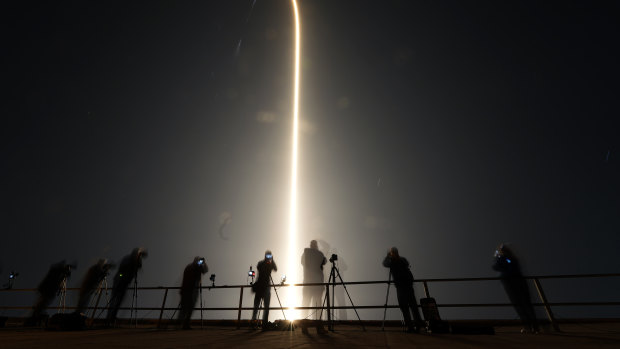
Globally, the fossil fuel industry released close to 120 million tonnes of methane into the atmosphere in 2023, the IEA found.
Loading
Why methane matters
When it escapes into the atmosphere methane, essentially the same substance we burn in our homes as natural gas, is 80 times more powerful a planet-warming agent than carbon dioxide. It is thought to have caused almost a third of the warming humans have caused since the industrial revolution.
When it is burnt it creates less warming emissions than energy sources like coal, so it has long been seen as a clean alternative to other fossil fuels.
But new research shows that far more methane escapes as so-called “fugitive emissions” in the process of extracting, processing and transporting gas, and from other sources such as open cut coal mines and waste dumps, than was previously acknowledged.
Because methane is so potent a warming agent, reducing its emissions could have an outsized impact on global warming.

A SpaceX Falcon 9 rocket lifts off in this time-exposure photo, from Launch Pad.Credit: AP
“We could basically cut warming nearly in half over the next couple of decades if we were to eliminate our methane emissions,” Ilissa Ocko, an atmospheric scientist at EDF, told Nature journal before the satellite was launched.
The methane moment
The Biden administration finalised contentious regulations designed to reduce US fossil fuel methane emissions by 80 per cent by 2035 in December. So far, over 155 nations, including Australia, have signed a pledge to cut methane emissions by 30 per cent of 2020 levels by 2030.
Meanwhile, more tools and projects are being deployed to detect methane, including a major program led by the United Nations that is collecting, integrating, and reconciling methane data from different sources.
If all methane pledges made by countries and companies to date were implemented in full and on time, it would be sufficient to cut methane emissions from fossil fuels by 50 per cent by 2030, the IEA’s new analysis found. But so far most pledges are not backed up by plans for implementation.
What it means for Australia
MethaneSAT’s Australian targets include coal fields in Victoria and Queensland as well as offshore gas installations in Western Australia. But it does not cover all the potential methane hotspots in the nation, says Associate Professor Bryce Kelly, a specialist in methane emissions with the University of New South Wales.
Kelly said Australia could have benefited from far more data from the satellite had it joined the project like New Zealand. But he said the impact of the satellite was already being felt before it was launched, with coal and gas companies announcing new projects to detect and plug their leaks before they were identified from space.
But he said ground and airborne measurements still needed to be conducted in Australia to ensure the data swept up by MethaneSAT was accurate once it started being provided.
A spokeswoman for Climate Change and Energy Minister Chris Bowen said the government’s emissions reporting continues to comply with UNFCCC guidelines and is reviewed annually and that it is considering suggestions for improvement from the recent review by the Climate Change Authority.
The good news
According to the IEA, tackling methane emissions is the most cost-effective way to tackle climate change because the gas captured from plugged leaks in pipelines or mines and landfills is a valuable energy source.
Around 40 per cent of methane emissions from fossil fuel operations in 2023 could have been avoided at no net cost because the value of the captured methane was higher than the cost of the abatement measure, the IEA found.
Reducing methane emissions from fossil fuels by 75 per cent by 2030 would require about US$170 billion in spending, less than 5 per cent of the income generated by the fossil fuel industry in 2023.
Get to the heart of what’s happening with climate change and the environment. Sign up for our fortnightly Environment newsletter.









 Add Category
Add Category